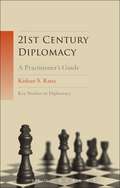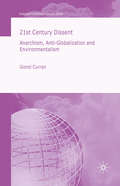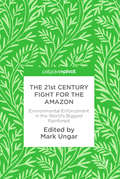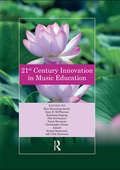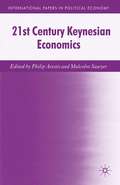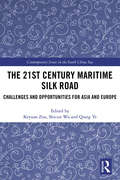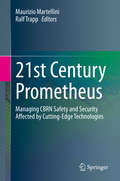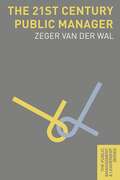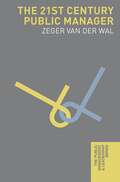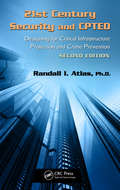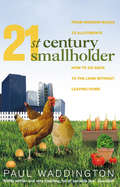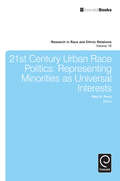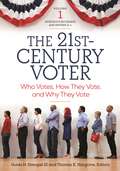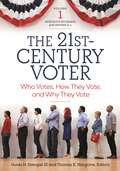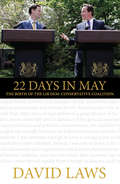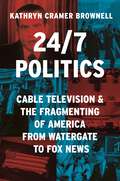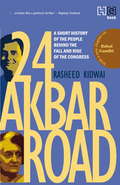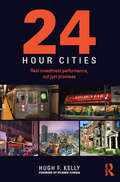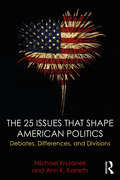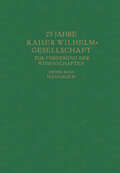- Table View
- List View
21st-Century Diplomacy: A Practitioner's Guide (Key Studies in Diplomacy)
by Kishan S. RanaIn the 21st century, new kinds of challenges resulting from interdependence among states and globalization have had a determining impact of the conduct of diplomacy.Diplomacy has become multifaceted, pluri-directional, volatile and intensive, due to the increased complexity in terms of actors, dialogues subjects, modes of communication, and plurality of objectives. This unique text, written by a leading scholar and Foreign Service expert, examines all such factors to provide the definitive guide to diplomacy as it is practiced today. With a multitude of examples from around the world, including the US, UK, EU, Africa, Asia, and Latin America, the book covers the spectrum of diplomacy practice, including regional diplomacy, diplomacy of small states, performance management, handling of decisions and crisis, use of information technology, and reform in foreign ministries. Also included are chapters on craft skills and practical exercises.21st Century Diplomacy will be essential to anyone learning diplomacy, and will also support courses in international relations, foreign policy, and intercultural communication.
21st-Century Diplomacy: A Practitioner's Guide (Key Studies in Diplomacy)
by Kishan S. RanaIn the 21st century, new kinds of challenges resulting from interdependence among states and globalization have had a determining impact of the conduct of diplomacy.Diplomacy has become multifaceted, pluri-directional, volatile and intensive, due to the increased complexity in terms of actors, dialogues subjects, modes of communication, and plurality of objectives. This unique text, written by a leading scholar and Foreign Service expert, examines all such factors to provide the definitive guide to diplomacy as it is practiced today. With a multitude of examples from around the world, including the US, UK, EU, Africa, Asia, and Latin America, the book covers the spectrum of diplomacy practice, including regional diplomacy, diplomacy of small states, performance management, handling of decisions and crisis, use of information technology, and reform in foreign ministries. Also included are chapters on craft skills and practical exercises.21st Century Diplomacy will be essential to anyone learning diplomacy, and will also support courses in international relations, foreign policy, and intercultural communication.
21st Century Dissent: Anarchism, Anti-Globalization and Environmentalism (International Political Economy Series)
by G. Curran21st Century Dissent contends that anarchism has considerably influenced the modern political landscape. Curran explores the contemporary face of anarchism as expressed via environmental protests and the anti-globalization movement.
The 21st Century Fight for the Amazon: Environmental Enforcement in the World’s Biggest Rainforest
by Mark UngarThis book is the most updated and comprehensive look at efforts to protect the Amazon, home to half of the world’s remaining tropical forests. In the past five years, the Basin’s countries have become the cutting edge of environmental enforcement through formation of constitutional protections, military operations, stringent laws, police forces, judicial procedures and societal efforts that together break through barriers that have long restrained decisive action. Even such advances, though, struggle to curb devastation by oil extraction, mining, logging, dams, pollution, and other forms of ecocide. In every country, environmental protection is crippled by politics, bureaucracy, unclear laws, untrained officials, small budgets, regional rivalries, inter-ministerial competition, collusion with criminals, and the global demand for oils and minerals. Countries are better at creating environmental agencies, that is, than making sure that they work. This book explains why, with country studies written by those on the front lines—from national enforcement directors to biologists and activists.
The 21st Century Fight for the Amazon: Environmental Enforcement in the World’s Biggest Rainforest
by Mark UngarThis book is the most updated and comprehensive look at efforts to protect the Amazon, home to half of the world’s remaining tropical forests. In the past five years, the Basin’s countries have become the cutting edge of environmental enforcement through formation of constitutional protections, military operations, stringent laws, police forces, judicial procedures and societal efforts that together break through barriers that have long restrained decisive action. Even such advances, though, struggle to curb devastation by oil extraction, mining, logging, dams, pollution, and other forms of ecocide. In every country, environmental protection is crippled by politics, bureaucracy, unclear laws, untrained officials, small budgets, regional rivalries, inter-ministerial competition, collusion with criminals, and the global demand for oils and minerals. Countries are better at creating environmental agencies, that is, than making sure that they work. This book explains why, with country studies written by those on the front lines—from national enforcement directors to biologists and activists.
21st Century Innovation in Music Education: Proceedings of the 1st International Conference of the Music Education Community (INTERCOME 2018), October 25-26, 2018, Yogyakarta, Indonesia
by Kun Setyaning Astuti Gary McPherson Bambang Sugeng Nila Kurniasari Tutut Herawan Christopher Drake Ashadi Endah Retnowati Adi Cilik PierewanMusic is an expression of feelings of the soul conveyed through the medium of sound. But not all sounds are music. It might be said that only an organised sound or series of sounds can be called music. Thus, music is connected to the eternal and constant flow and order of the universe, to the laws and rhythms of nature. It can also be said that musical order is comparable to the natural order of the universe. There are laws of a certain nature in the natural sciences and likewise in music there are structures and procedures, or even rules, that should be followed to produce beautiful music. The International Conference "Innovations for 21st Century Music Education and Research" provided a timely opportunity to take stock of the latest developments in music education and brought together educators, researchers and members of the broader community in a welcoming forum in which they were able to express theoretical and practical views, concepts, research results and principles to help support the further development of music education.
21st Century Keynesian Economics (International Papers in Political Economy)
by Malcolm Sawyer P. ArestisThe current global financial and economic crisis has called for the revival of Keynesian theory. This sixth volume in the International Papers in Political Economy (IPPE) series focuses on twenty first century Keynesian economics in terms of both theory and application.
The 21st Century Maritime Silk Road: Challenges and Opportunities for Asia and Europe (Contemporary Issues in the South China Sea)
by Keyuan Zou Shicun Wu Qiang YeThis book explores the opportunities and challenges that both Europe and Asia face under the framework of the 21st Century Maritime Silk Road Initiative. The 21st Century Maritime Silk Road Initiative (MSR Initiative), put forward by the Chinese government together with the Silk Road Economic Belt, reflects China’s ambition and vision to shape the global economic and political order. The first step and priority under the MSR Initiative, according to documents issued by China, is to build three ‘Blue Economic Passages’ linking China with the rest of the world at sea, two of which will connect China with Europe. This initiative, however, still faces enormous challenges of geopolitical suspicion and security risks. This book seeks to assess these risks and their causes for the cooperation between the Eurasian countries under the framework of MSR and puts forward suggestions to deal with these risks in the interdisciplinary perspectives of international relations and international law. Featuring a global team of contributors, this book will be of much interest to students of Asian politics, maritime security, international law and international relations.
The 21st Century Maritime Silk Road: Challenges and Opportunities for Asia and Europe (Contemporary Issues in the South China Sea)
by Keyuan Zou Shicun Wu Qiang YeThis book explores the opportunities and challenges that both Europe and Asia face under the framework of the 21st Century Maritime Silk Road Initiative. The 21st Century Maritime Silk Road Initiative (MSR Initiative), put forward by the Chinese government together with the Silk Road Economic Belt, reflects China’s ambition and vision to shape the global economic and political order. The first step and priority under the MSR Initiative, according to documents issued by China, is to build three ‘Blue Economic Passages’ linking China with the rest of the world at sea, two of which will connect China with Europe. This initiative, however, still faces enormous challenges of geopolitical suspicion and security risks. This book seeks to assess these risks and their causes for the cooperation between the Eurasian countries under the framework of MSR and puts forward suggestions to deal with these risks in the interdisciplinary perspectives of international relations and international law. Featuring a global team of contributors, this book will be of much interest to students of Asian politics, maritime security, international law and international relations.
21st Century Prometheus: Managing CBRN Safety and Security Affected by Cutting-Edge Technologies
by Maurizio Martellini Ralf TrappThis book describes the evolving CBRN risk landscape and highlights advances in the “core” CBRN technologies, including when combined with (improvised) explosive devices (CBRNe threats). It analyses how associated technologies create new safety and security risks, challenging certain assumptions that underlie current control regimes. The book also shows how technologies can be enablers for more effective strategies to mitigate these risks.21st-century safety and security risks emanating from chemical, biological, radiological and nuclear materials – whether resulting from natural events, accidents or malevolent use - are increasingly shaped by technologies that enable their development, production or use in ways that differ from the past. Artificial intelligence, the use of cyberspace, the revolution in the life sciences, new manufacturing methods, new platforms and equipment for agent delivery, hypersonic weapons systems, information tools utilised in hybrid warfare – these and other technologies are reshaping the global security environment and CBRN landscape. They are leading to a growing potential for highly targeted violence, and they can lead to greater instability and vulnerability worldwide. At the same time, technology offers solutions to manage CBRN risks. Examples are faster detection, more accurate characterisation of the nature and origin of CBRN agents, new forensic investigation methods, or new medical treatments for victims of CBRN incidents. New educational concepts help to foster a culture of responsibility in science and technology and strengthen governance. New training methods help develop practical skills to manage CBRN risks more effectively.The book concludes that there is a growing need for a holistic framework towards CBRN risk mitigation. Traditional arms control mechanisms such as global, regional or bilateral treaties and export controls are still needed, as they provide a necessary legal and institutional framework. But laws and technology denial alone will not suffice, and institutional mechanisms can at times be weak. Given the pace of technological progress and the diffusion of critical knowledge, tools and materials, policymakers must accept that CBRN risks cannot be eliminated altogether. Instead, society has to learn to manage these risks and develop resilience against them. This requires a “softer”, broadly based multi-stakeholder approach involving governments, industry, the research and development communities, educators, and civil society. Furthermore, educating policymakers that cutting-edge technologies may seriously affect global strategic stability could create incentives for developing a more creative and contemporary arms control strategy that fosters cooperation rather than incremental polarisation.
The 21st Century Public Manager (The Public Management and Leadership Series)
by Zeger Van WalTruly global in scope and ambition, the 21st Century Public Manager addresses key trends, challenges, and opportunities facing public managers across contexts and regimes. This accessible textbook aims to inspire public managers in rethinking their roles, skills, and values as they enter a VUCA world-one characterized by volatility, uncertainty, complexity, and ambiguity. It is written for aspiring and current public managers in graduate schools and executive education programs.
The 21st Century Public Manager (The Public Management and Leadership Series)
by Zeger van der WalTruly global in scope and ambition, the 21st Century Public Manager addresses key trends, challenges, and opportunities facing public managers across contexts and regimes. This accessible textbook aims to inspire public managers in rethinking their roles, skills, and values as they enter a VUCA world—one characterized by volatility, uncertainty, complexity, and ambiguity. It is written for aspiring and current public managers in graduate schools and executive education programs.
21st Century Security and CPTED: Designing for Critical Infrastructure Protection and Crime Prevention, Second Edition
by Randall I. AtlasThe concept of Crime Prevention Through Environmental Design (CPTED) has undergone dramatic changes over the last several decades since C. Ray Jeffery coined the term in the early 1970s, and Tim Crowe wrote the first CPTED applications book. The second edition of 21st Century Security and CPTED includes the latest theory, knowledge, and practice of
21st-Century Smallholder: From Window Boxes To Allotments: How To Go Back To The Land Without Leaving Home
by Paul WaddingtonAchieving genuine self-sufficiency of the kind described in John Seymour's classic guide is sadly beyond the vast reach of the urban majority today. Few have the space, and for those few there are comprehensive guidebooks. But where do the rest of us look for the answers to questions like how much effort does it really take to grow your own food? Is beekeeping difficult? Is solar power really worth the bother?From a small terraced house in the middle of a big city, Paul Waddington has made it his business to find out, and while trying it himself, has created a practical and absorbing guidebook along the way. It includes easy-to-read lists, tables, personal anecdote, and stunning illustrations, and more importantly demystifies the subject with practical tips that get to the heart of the matter to show you how you can enjoy the fulfilling aspects of the smallholding life without the hassle and expense of 'going all the way'. If you want to go back to the land without leaving home, this is the perfect guide.
21st Century Urban Race Politics: Representing Minorities as Universal Interests (Research in Race and Ethnic Relations #18)
by Ravi K. Perry Donald Cunnigen Marino A. Bruce21st Century Urban Race Politics begins by offering a twenty-first-century understanding of minority representation in historically majority-Caucasian cities and draws on case studies in cities throughout the United States. The aim of this volume is to take stock of what we know about the advantages and disadvantages of the "racialized" and "deracialized" approaches to governance and to describe a third approach, the "universalized interest approach." The authors argue that minority elected officials, when given the power and resources to do so, often do more than represent constituent interests without acknowledging the representation of members of their racial/ethnic group in urban communities. Contributors describe how mayors of various backgrounds have sought to represent minority interests in electoral and governing contexts. In each case, the mayors are found to represent minority interests. In most cases, the representation of minority interests is accomplished without deemphasizing the significance of race and as the mayor maintains support from whites within their electoral and governing coalitions. With case studies from across the country, in medium-sized and large cities, and mayors of various backgrounds, the volume provides a vivid account of how different minority mayors have handled minority representation in historically majority Caucasian cities and what lessons academics and politicians can learn from them.
The 21st-Century Voter [2 volumes]: Who Votes, How They Vote, and Why They Vote [2 volumes]
by Guido H. Stempel III and Thomas K. HargroveThis comprehensive reference covers all aspects of politics and voting—from elections and campaigns, to major political figures and parties, to the role of media and major activist groups.As America's population changes, so do its political trends. This insightful resource captures the evolution of American politics and elections in the 21st century, explaining the identities and roles of lobbyists, activists, politicians, and voters. Featuring contributions from distinguished researchers and academics in the areas of political science, social science, and journalism, this encyclopedia explores the contemporary political landscape, offering an opportunity to compare and contrast related decisions, events, and statistical information from the recent past. Informative background essays explore all aspects of voting-related politics and policy, evolving electoral trends and the issues that account for those changes, and the impact of the ever-changing composition of America's population on polling and elections. This work incorporates the results of the 2012 elections, thus providing important insights into modern voting trends and their meaning for the future of the United States.
The 21st-Century Voter [2 volumes]: Who Votes, How They Vote, and Why They Vote [2 volumes]
This comprehensive reference covers all aspects of politics and voting—from elections and campaigns, to major political figures and parties, to the role of media and major activist groups.As America's population changes, so do its political trends. This insightful resource captures the evolution of American politics and elections in the 21st century, explaining the identities and roles of lobbyists, activists, politicians, and voters. Featuring contributions from distinguished researchers and academics in the areas of political science, social science, and journalism, this encyclopedia explores the contemporary political landscape, offering an opportunity to compare and contrast related decisions, events, and statistical information from the recent past. Informative background essays explore all aspects of voting-related politics and policy, evolving electoral trends and the issues that account for those changes, and the impact of the ever-changing composition of America's population on polling and elections. This work incorporates the results of the 2012 elections, thus providing important insights into modern voting trends and their meaning for the future of the United States.
22 Days in May: The Birth of the Lib Dem-Conservative Coalition
by David Laws22 Days in May is the first detailed Liberal Democrat insider account of the negotiations which led to the formation of the Lib Dem/Conservative coalition government in May 2010, along with an essential desription of the early days of the government.
24/7 Politics: Cable Television and the Fragmenting of America from Watergate to Fox News (Politics and Society in Modern America #148)
by Kathryn Cramer BrownellHow cable television upended American political life in the pursuit of profits and influenceAs television began to overtake the political landscape in the 1960s, network broadcast companies, bolstered by powerful lobbying interests, dominated screens across the nation. Yet over the next three decades, the expansion of a different technology, cable, changed all of this. 24/7 Politics tells the story of how the cable industry worked with political leaders to create an entirely new approach to television, one that tethered politics to profits and divided and distracted Americans by feeding their appetite for entertainment—frequently at the expense of fostering responsible citizenship.In this timely and provocative book, Kathryn Cramer Brownell argues that cable television itself is not to blame for today’s rampant polarization and scandal politics—the intentional restructuring of television as a political institution is. She describes how cable innovations—from C-SPAN coverage of congressional debates in the 1980s to MTV’s foray into presidential politics in the 1990s—took on network broadcasting using market forces, giving rise to a more decentralized media world. Brownell shows how cable became an unstoppable medium for political communication that prioritized cult followings and loyalty to individual brands, fundamentally reshaped party politics, and, in the process, sowed the seeds of democratic upheaval.24/7 Politics reveals how cable TV created new possibilities for antiestablishment voices and opened a pathway to political prominence for seemingly unlikely figures like Donald Trump by playing to narrow audiences and cultivating division instead of common ground.
24 Akbar Road [Revised and Updated]: A Short History of the People behind the Fall and Rise of the Congress
by Rasheed KidwaiNow updated with a new chapter on Rahul Gandhi The Congress party has always stayed one step ahead of the opposition by constantly reinventing and re-aligning itself to stay in sync with the political realities of the day. Its president, Sonia Gandhi, pulled off a master-coup in 2004 by declining the prime-ministership, while the incumbent Congress Prime Minister Dr Manmohan Singh is the first prime minister since Nehru to lead the party into two Union government terms. In 2013, Rahul Gandhi was elevated to the post of Congress vice-president amid much fanfare and optimism. Tasked with reviving the grand old party, the young politician remains, in the minds of many, the best hope to lead the Congress into the next century, marking a new moment in the Congress’s concept of ‘continuity with change’. In his bestselling book 24 Akbar Road, seasoned journalist and veteran Congress watcher Rasheed Kidwai puts together an incisive and engaging account of the Congress’s shape-shifting nature and its tenuous hold at the Centre, providing a dispassionate observer’s glance at affairs within the Congress. Kidwai brilliantly tracks the story of the contemporary Congress in the years after the Emergency, using the Congress seat of power at 24 Akbar Road as his vantage to draw a compelling account of the Congress leadership from Indira, Sanjay and Rajiv Gandhi to Narasimha Rao and Sitaram Kesri, to the present- day trinity of Sonia Gandhi, Manmohan Singh and Rahul Gandhi. In this revised and updated edition, Kidwai analyses Rahul Gandhi’s appointment to assess what the Congress needs to do to remain India’s nerve of power in the coming years, and whether the new vice- president can rally the party to a third consecutive victory at the Centre.'
24-Hour Cities: Real Investment Performance, Not Just Promises
by Hugh F. KellyWinner of the Gold Award in the Tenth Annual Robert Bruss Real Estate Book Competition 24 Hour Cities is the very first full length book about America’s cities that never sleep. Over the last fifty years, the nation’s top live-work-play cities have proven themselves more than just vibrant urban environments for the elite. They are attracting a cross-section of the population from across the U.S. and are preferred destinations for immigrants of all income strata. This is creating a virtuous circle wherein economic growth enhances property values, stronger real estate markets sustain more reliable tax bases, and solid municipal revenues pay for better services that further attract businesses and talented individuals. Yet, just a generation ago, cities like New York, Boston, Washington, San Francisco, and Miami were broke (financially and physically), scarred by violence, and prime examples of urban dysfunction. How did the turnaround happen? And why are other cities still stuck with the hollow downtowns and sprawling suburbs that make for a 9-to-5 urban configuration? Hugh Kelly’s cross-disciplinary research identifies the ingredients of success, and the recipe that puts them together.
24-Hour Cities: Real Investment Performance, Not Just Promises
by Hugh F. KellyWinner of the Gold Award in the Tenth Annual Robert Bruss Real Estate Book Competition 24 Hour Cities is the very first full length book about America’s cities that never sleep. Over the last fifty years, the nation’s top live-work-play cities have proven themselves more than just vibrant urban environments for the elite. They are attracting a cross-section of the population from across the U.S. and are preferred destinations for immigrants of all income strata. This is creating a virtuous circle wherein economic growth enhances property values, stronger real estate markets sustain more reliable tax bases, and solid municipal revenues pay for better services that further attract businesses and talented individuals. Yet, just a generation ago, cities like New York, Boston, Washington, San Francisco, and Miami were broke (financially and physically), scarred by violence, and prime examples of urban dysfunction. How did the turnaround happen? And why are other cities still stuck with the hollow downtowns and sprawling suburbs that make for a 9-to-5 urban configuration? Hugh Kelly’s cross-disciplinary research identifies the ingredients of success, and the recipe that puts them together.
The 25 Issues that Shape American Politics: Debates, Differences, and Divisions
by Michael Kryzanek Ann K. KarrethThis book is organized to examine the major subjects taught in American politics through the lens of twenty-five hot button issues affecting American politics and policy today. These key issues reflect the ideas, principles, concerns, fears, morals, and hopes of the American people. The authors argue that these issues are the heart and soul of the American political system, serving as the basis for the disagreements that drive citizens, public servants, and elected officials into action. Features of this Innovative Text Examines 25 issues in light of the 2016 presidential election and beyond. Up-to-date chapters reflect important developments in the arenas of immigration, health care, race relations and civil rights, gun control, gay rights, and money and politics, in particular. Includes international coverage with recent and ongoing events surrounding Iran, Syria, Israel and Palestine, and China. A chapter on Russia puts recent developments in Syria, Ukraine, Crimea, and the "near abroad" in context with US foreign policy.
The 25 Issues that Shape American Politics: Debates, Differences, and Divisions
by Michael Kryzanek Ann K. KarrethThis book is organized to examine the major subjects taught in American politics through the lens of twenty-five hot button issues affecting American politics and policy today. These key issues reflect the ideas, principles, concerns, fears, morals, and hopes of the American people. The authors argue that these issues are the heart and soul of the American political system, serving as the basis for the disagreements that drive citizens, public servants, and elected officials into action. Features of this Innovative Text Examines 25 issues in light of the 2016 presidential election and beyond. Up-to-date chapters reflect important developments in the arenas of money and politics, immigration, health care, race relations and civil rights, gun control, and gay rights in particular. Includes international coverage with recent and ongoing events surrounding Iran, Syria, Israel and Palestine, and China. A chapter on Russia puts recent developments in Syria, Ukraine, Crimea, and the "near abroad" in context with US foreign policy.
25 Jahre Kaiser Wilhelm-Gesellschaft zur Förderung der Wissenschaften: Erster Band Handbuch
by Max Planck Kaiser-Wilhelm-Ges. zur Förderung der WissenschaftenDieser Buchtitel ist Teil des Digitalisierungsprojekts Springer Book Archives mit Publikationen, die seit den Anfängen des Verlags von 1842 erschienen sind. Der Verlag stellt mit diesem Archiv Quellen für die historische wie auch die disziplingeschichtliche Forschung zur Verfügung, die jeweils im historischen Kontext betrachtet werden müssen. Dieser Titel erschien in der Zeit vor 1945 und wird daher in seiner zeittypischen politisch-ideologischen Ausrichtung vom Verlag nicht beworben.
